On Wednesday, Tesla revealed its vehicle production and delivery numbers for the third quarter of 2024, showcasing the company’s ongoing challenges and successes in the electric vehicle (EV) market. The figures reported were total deliveries of 462,890 and total production of 469,796. Despite these substantial numbers, Tesla’s stock took a hit, dropping as much as 3.7% on Monday morning following the announcement. This decline reflects a sentiment in the market that is becoming increasingly cautious regarding the electric automaker’s growth trajectory.
Analysts had anticipated deliveries to reach approximately 463,310 units for the quarter ending September 30. While Tesla’s numbers came close, they still fell short of the analyst expectations, casting a shadow over what could have been perceived as a successful quarter. Historically, Q3 2023 saw Tesla achieving 435,059 deliveries and 430,488 in production, and more recently, in Q2 2024, they reported 443,956 deliveries. Although the numbers show year-over-year growth, the marginal miss against expectations may signal deeper issues concerning market positioning and competition.
Tesla is experiencing heightened competitive pressures, particularly from Chinese automakers such as BYD and Geely, which are aggressively expanding their EV market share. Additionally, companies like Li Auto and Nio are fostering innovations that challenge Tesla’s dominance. In the U.S., Tesla faces stiff competition not only from emerging EV manufacturers such as Rivian but also from traditional automakers like Ford and General Motors (GM). GM, for instance, has reported a remarkable 60% year-over-year increase in EV sales for the third quarter, although these units only totaled 32,100—still significantly behind Tesla.
Tesla’s continued success in deliveries and production may be tested in the coming quarters as competitors refine their offerings and strategies. Although Tesla’s products remain at the forefront of the electric vehicle market due to their established brand recognition and network of services, the landscape is changing rapidly, with competitors gaining momentum and eroding Tesla’s traditional advantages.
Tesla has not officially defined its delivery guidance for 2024 but has indicated that it expects a lower growth rate compared to previous years. This indicates a cautious outlook in light of increasing competition and market saturation. Although Tesla’s newest addition, the Cybertruck—a vehicle with an unconventional design—represents the company’s ongoing commitment to innovation, it raises questions about whether this model can significantly impact overall sales performance in the near term.
Interestingly, Tesla also reported deploying 6.9 GWh of energy storage products in the same quarter. This move signals Tesla’s strategy to diversify its offerings, encompassing not just electric vehicles but also energy solutions that may reinforce its market position. As the company prepares for its upcoming third-quarter earnings report, stakeholders will be closely analyzing profit margins and other financial metrics to gauge the effectiveness of these strategies in maintaining Tesla’s competitive edge.
Tesla’s brand has faced scrutiny, particularly in the United States, partially attributed to the controversial actions and statements of CEO Elon Musk. From political endorsements to contentious remarks on his social media platform X, Musk’s public persona has placed additional pressure on Tesla’s image. While Tesla continues to outsell all other automakers in the battery electric vehicle sector, with Hyundai trailing significantly, the company’s reputation could be at risk if these issues persist.
As Tesla moves forward, its commitment to attractive financing options and sales incentives is critical for driving consumer interest, particularly in the U.S. and China. However, as competitors like Waymo and Pony.ai advance in commercial robotaxi services—something Tesla has yet to deliver on despite promises—the urgency for Tesla to innovate and recalibrate its marketing strategies increases.
Tesla’s Q3 2024 report illuminates a complex landscape filled with both opportunities and challenges. While production and delivery numbers reflect a robust operation, they also suggest the need for strategic reevaluations to navigate a rapidly evolving market. As competition intensifies and consumer sentiments shift, maintaining leadership in the EV space will demand not just innovation, but also astute management of the brand and public perception.


Leave a Reply